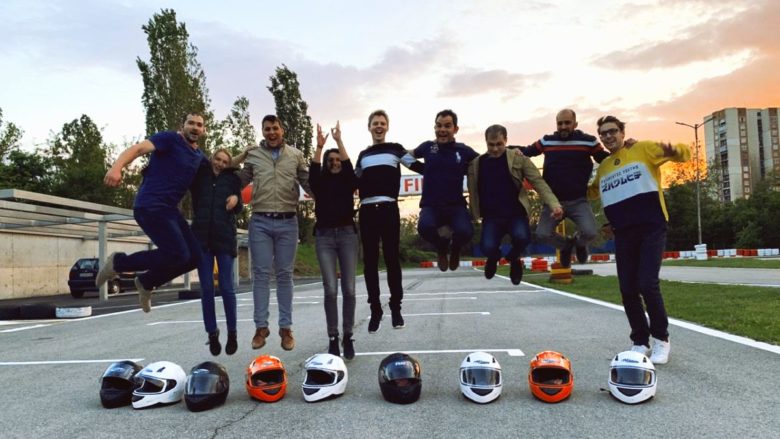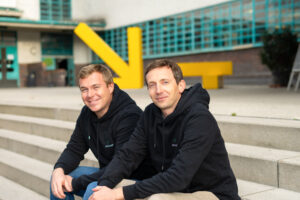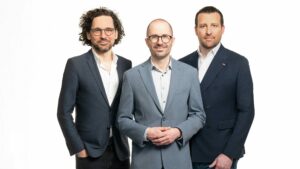Inside Scaleflex: The Fully Remote Startup Where Chаllenges Are Delegated Instead Of Tasks

Own projects, constant feedback loop over Telegram, and physical meetups three times a year. This is how Scaleflex, the fully remote startup with a team of 15, across seven countries, operates.
Scaleflex is a venture that develops digital image optimization and media asset storage products and works between Paris, Munich, and three locations in Bulgaria. Founded in 2016 by Emil Novakov and Julian De Maestri, the company has doubled its revenue year-over-year and is expecting to reach €1M annual recurring revenue (ARR) by the end of 2020.
Self-funded with founders’ own savings of €150K and with two products on the market, last year Scaleflex received a small pre-seed round of €200K from BrightCap to make its next step.
Initially, the startup launched a product called Cloudimage that was helping developers, but also marketers, to easily resize and manage images, and thus accelerate the loading speed of websites. Last summer, Scaleflex launched another product called Filerobot that can also store all media assets (images, videos, audio, code, files, etc.), process them and eventually accelerate their distribution worldwide to improve overall asset lifecycle management and web performance. So far, the company has attracted over 400 customers, one-third of which are paying.
Although CEO Emil Novakov sees the growing demand for solutions like this and a market expected to reach $6-7b in the next years, growth at any price is not his first priority. Indeed, he first wants to build a company where everyone feels well and can develop.
But to make that possible in a fully remote company, he is very careful about every person he hires.
Trending Topics: Was it a conscious decision to be a fully remote organization?
Emil Novakov: At the very beginning, Julian was working on our first product and I was just helping out.
When we closed the first big deal with a client in 2016, we decided that we should actually push it more. So, we started working with freelancers and outsourcing companies in Ukraine and Belarus. Two of the people from those companies later came to work with us and turned into our core developers. It all started remotely, but back then we were four people.
I was not expecting it to work out with 15 people. Yet, it turns out it’s possible. It’s not a coincidence that we read in the press about virtual and fully remote companies. There are even several unicorns that have managed to do it.
In 2017, we hirеd the first person in Bulgaria, and we started gradually growing. Everyone started bringing people they knew and trusted. So, it was a bit of a snowball effect. Currently, we are 15 people, and planning to extend the team, mostly in Bulgaria.
What are the challenges and what does your organization look like?
The biggest challenge is to have an overview of what everyone in the team is doing and to be able to track that. Yet, we are not micromanagers and don’t want to be constantly chasing the people and track every step of their work, we’ve automated a lot of the processes.
Secondly, we expect autonomy from the people. ScaleFlex delegates problems, not tasks. That’s generally the mindset. The person or the team that is working on a specific problem is self-organized and agile. We are in a constant feedback loop through instant-messaging platforms. Each team player is working independently, so they really feel they are running their own projects but not tasks that we’ve delegated.
+++ Scaleflex Picks Up A Six Digit Investment From BrightCap Ventures +++
How often do you see each other?
Three times a year we make sure we spend a week together, and there’s a conference call for the whole team once a week. Now as we grow, we are starting to have specific team calls – one for the sales team, one for the dev team, etc.
As a CEO, how do you maintain the motivation of the team given the fact that you don’t see each other?
To make a fully remote company really work, you need autonomous team members, as simple as that. Only people who don’t need a manager to give them tasks are suitable for such a company.
One of my former bosses used to say: “There are three types of people in this world. Those you tell what to do and they don’t do it, those you tell what to do and they do it, and the ones you don’t need to tell what to do.” We are looking for people from the third category – the ones that take the initiative to deal with the problems as if they are their own and are good communicators.

How do you assess all these qualities from distance and how often do you meet people in person before you hire them?
It’s not that hard. Indeed, we hadn’t physically met half of the current team members before we hired them. In any case, one thing we do, and it’s part of our interview process, is to put the applicant on Telegram, give them a task and let them work with the team for half a day. This way we see whether we are able to easily communicate and understand each other.
What are the advantages and disadvantages of being a fully remote company?
Work-hour flexibility is a major plus. Of course, we make sure we synchronize with each other, but there is a lot of flexibility. It’s important the work to get done, not the number of working hours. It’s also time-efficient because we don’t waste time traveling to an office, which is a problem, especially in big cities.
And not least, there’s one strange benefit I observed, at least in our team. We don’t see each other that often, every time we sit together and I give an update of the company performance, everyone gets the feeling that we are making greater progress than we actually do.
Although we are open about everything in the company all the time, and even developers know how our revenue is growing, most of the time people are concerned with their own projects. When we finally meet they can see the whole picture and the actual development of the company.
What has been the biggest challenge since the start of the company?
Probably the biggest one was to build a team and culture while being totally unknown and with no money for giant wages. The only thing that helped us was to give people motivation, vision and visible progress. I really think our main values related to passion and commitment are what brought the core team together. We also make sure everyone from the core team has a stake in the company.
What’s that vision you are talking about all the time?
It’s related to where we started and where we want to go. We first started with optimizing pictures, a product that was mainly targeted at developers, but then we were quick enough to launch new products because there was a demand for that.
Now we are in the digital asset management space and work with bigger clients with different budgets. Having said that, this is a rather new market that is expected to grow fast in the next years reaching $6-7B in 2023, and we want to be a leader in it.
Moreover, we want to build a company and a working environment where everyone can thrive and excel. I think this should be the number one goal for every business.
This may also interest you:


























